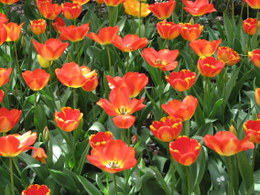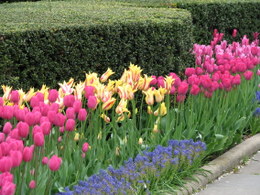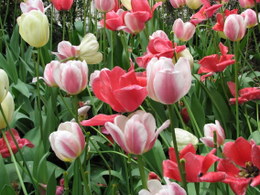Tulip Growing Guide
Tulip (Tulipa spp.) is a perennial spring blooming flower native to southern Europe to Central Asia. Their early blooms are a welcome addition to every flower garden and will do well in USDA Zones 4 to 7.
Extensive hybridizing has weakened their ability to come back, so many gardeners’ plant new bulbs in the fall. If you want reliable perennial varieties look for Darwin Hybrids and Emperor.
There are varieties ranging from 6 to 24-inches high and spread 4 to 6-inches wide. Bloom times are from mid-spring to late-spring, with colors of red, pink, white, orange, yellow, violet and indigo. In addition to solid colors there are bi-color varieties with flame-like stripes and others with contrasting centers.
In addition to the familiar cup shaped bloom there are fringed petals, Parrot tulips have ridged and rumpled petals, Lily Flowered varieties have colorful long pointed petals.
They are often planted in large mass plantings of 50 or more bulbs, or in flower beds behind early spring blooming muscari and hyacinths.
When purchasing your bulbs look for the largest ones, which will have the most energy stored up. Reject any that are small or shriveled up.
There are many varieties available which will determine the time of blooming. Sunny locations and protected areas next a building foundation will bloom earlier.
Because deer and squirrels like to eat tulips, most suburban and rural gardeners do not plant them, however they often can be successfully grown in a flower bed placed alongside a well-traveled road.
Poultry netting, also called chicken wire can be placed over the bulbs and covered with a few inches of soil to help deter squirrels.
The best time to buy the bulbs is when they show up in the garden centers. You can then store them properly in a cool dark location so that the bulbs will be at their best when you plant them.
Soil Preparation
Plant your tulips in full sun to part sun in a nice loose well-drained garden soil and will do best in a slightly acid soil with a pH range of 6.0 to 7.0.
When to Plant
They should be planted in the fall after the first frost, but before the ground freezes. A good time is when the soil temperature drops below 60-degrees F. The bulb needs a period of time to develop a good root system before the ground freezes. In most areas this will be around the end of October or early November.
Planting Tulips
Follow the grower’s instructions. In general plant the bulbs 6 to 8-inches deep and 6-inches apart. For the best visual affect plant the bulbs in groups of 3 or 5.
When planting the bulbs, place the bulb with the pointed end up. After planting the bulbs, cover with a light layer of mulch to conserve moisture and protect the new bulbs during the winter.
They are often sold in bags of 10 or 20-bulbs and a large mass planting is very attractive.
Typical blooms are 18 to 30-inches high and should be planted behind other lower spring blooming flowers such as hyacinth, muscari and primrose.
Water your bulbs every 7 to 10-days for good root development until the ground freezes.
Watering and Care
They are low maintenance and easy to care for. All you need to do is add a layer of mulch to help retain moisture and keep out competing weeds. Your bulbs should get an inch of water each week during their growing and blooming season and during dry spells give some water to keep the soil moist.
They usually do not need any fertilizer, but a light side dressing of low nitrogen slow release 3-5-3 organic fertilizer such as Espoma Bulb Tone can be applied. Following the directions, apply around the bulbs when planting and after they have finished blooming.
After the flowers have faded it is a good practice to remove the dried up blooms. This will stop seeds from forming and will put more energy into the bulb to make more flowers for next year. Do not remove the foliage until it has yellowed and died back.
Diseases and Pests
Tulips are usually trouble free. Bulb rot, gray mold and nematodes are the most common diseases. Buy inspected bulbs and do not plant any bulbs that look moldy or look infected in any way. Proper well-drained soil is important. Dig up any infected plants and put in the trash, not the compost pile.
Squirrels, mice, and voles will eat the bulbs and deer will eat the flowers and foliage.
Popular Varieties
Popular varieties by color:
Maroon: Havran, Jan Reus, Queen of the Night, Ronaldo.
Orange: Bestseller, Typhoon, Cairo.
Pink: Big Chief, Pink Impression, Angelique.
Purple: Bessie, Negrita, Purple Flag.
Red: Apeldoorn, Gordon Cooper, Van Eijk, Bastogne, Red Dynasty.
Yellow: Golden Oxford, Hans Mayer, Jewel of Spring, Monsella.
White: Ivory Floradale, Mondial, White Triumphator.
Sources: American Meadows, Breck’s, White Flower Farm.
Garden Spikes newsletters give you timely information once or twice a month. Subscribe Free to the Garden Times newsletter below.
Your email address will only be used to send you a newsletter and will never be sold. You can unsubscribe at any time.



